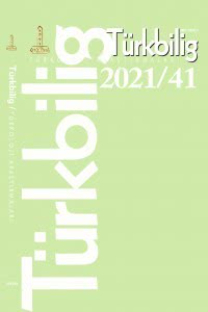BİR BATILININ GÖZÜNDEN 18. YÜZYILDA ÇUVAŞLAR: JOHANN GOTTLİEB GEORGİ VE ÇUVAŞLARA İLİŞKİN KAYITLARI
Chuvash at the 18th Century through the Eye of a Westerner: Johann Gottlieb Georgi and His Records of Chuvash People
___
AGYAGÁSİ, K. (1982), On the Edition of Chuvash Literary Sources Chuvash Studies, Budapest: Akadémiai Kiadó, s. 7-18ARIK, D. (2005), Hıristiyanlaştırılan Türkler (Çuvaşlar), Ankara: Aziz Andaş Yayınları.
AŞMARİN, N. İ. (1982), Vvedeniye v Kurs Çuvaşskoy Narodnoy Slovesnosti, Çuvaşskiy Folklor Spetsifika Janrov, Çeboksarı.
............., (1994-2000), Slovar Çuvaşskogo yazıka − Çĭvaş Sĭmahĩsen Kĩneki, 17 Cilt, Çeboksarı: Russika. (=ÇSK).
BAYRAM, B. (2010), Çuvaş Türklerinin Kahramanlık Anlatmaları (Alplar), Ankara: Türk Kültürünü Araştırma Enstitüsü Yayınları.
FEDOTOV, M. P. (1987), İssledovateli Çuvaşskogo Yazıka, Çeboksarı: Çuvaşskoye Knijnoye İzdatelstvo.
GEORGİ, J. G. (1776), Beschreibung aller Nationen des Russischen Reichs, ihrer Lebensart, Religion, Gebräuche, Wohnungen, Kleidung und übrigen Merckwürdigkeiten, St. Petersburg.
............., (1780), Russia: or, a compleat historical account of all the nations which compose that Empire, London: Printed for J. Nichols, T. Cadell, H. Payne, N. Conant.
............., (1799), Opisanie vseh obitayuşçih v Rossiyskom gosudarstve narodov. İh jiteyskih obryadov, obıknoveniy, odejd, jiliş, uprajneniy, zabav, veroispovedaniy i drugih dostopamyatnostey, Sanktpeterburg: İmperatorskoy Akademii Nauk.
GORDOYEV, F. İ. (1979), Etimologiçeskiy Slovar Mariyskogo Yazıka Tom I (A-B), Yoşkor-Ola: Mariyskoye Knijnoye İzdatelstvo.
HEİN, O. (1964), Georgi, Johann Gottlieb, Neue Deutsche Biographie 6, s. 242; http://www.deutsche-biographie.de/pnd136429157.html, 15, 12, 2014.
Hrestomatiya po kulture çuvaşskogo kraya, Dorevolyutsionnıy period (2011), Çeboksarı: Çuvaşskoye Knijnoye İzdadelstvo (=Hrestomatiya)
İVANOV-ORKOV, G. N. (2009), Sarĭ Çuvaşskaya Éntsiklopediya, C. 3, Çeboksarı: Çuvaşskoye Knijnoye İzdatelstvo.
............., (2011a), Huşpu Çuvaşskaya Éntsiklopediya, C. 4, Çeboksarı: Çuvaşskoye Knijnoye İzdatelstvo.
............., (2011b), Surpan Çuvaşskaya Éntsiklopediya, C. 4, Çeboksarı: Çuvaşskoye Knijnoye İzdatelstvo.
KÖHLER, M. (2012), Russische Ethnographie und imperiale Politik im 18. Jahrhundert, Göttingen: Vandenhoeck & Ruprecht.
MATVEYEV, G. B. (2011), Hĩrlĩ Şır, Çuvaşskaya Éntsiklopediya, C. 4, Çeboksarı: Çuvaşskoye Knijnoye İzdatelstvo.
PETROV, N. P. (1978), Çĭvaş literatura çĩlhin istoriyĩ, Şupaşkar: Çuvaşskiy Gosudarstvennıy Universitet.
RATZEL, F. (1878), Georgi, Johann Gottlieb, Allgemeine Deutsche Biographie, s. 713; http://www.deutsche-biographie.de/pnd136429157.html, 15, 12, 2014.
RÓNA-TAS, A. (1978), An Unpublished Chuvash Wordlist in the Library of the Hungarian Academy of Sciences, Jubilee Volume of the Oriental Collection, Budapest, 159-173
SERGEYEV, L. P. (1969), O Pamyatnikah çuvaşskoy pismennosti XVIII veka, Uçenıe Zapiski Vıpusk 46, 228-263.
............., (1988), Kivĩ Çĭvaş şırulĭhĩ, Şupaşkar: Çuvaşskiy Gosudarstvennıy Universitet.
............., (2004), XVIII Ĩmĩrti çĭvaş şırulĭhĩn palĭkĩsem uçebnik-hrestomati, İ. Ya. Yakovlev Yaçĩllĩ Çĭvaş Patşalĭh Pedagogika Üniversiteçĩ.
............., A. D. Ahvanderova, (2007), Turi Dialekt XIX ĩmĩr puşlamĭşĩnçi leksika, Şupaşkar: Çuvaşskiy Gosudarstvennıy pedagogiçeskiy universitet.
SCHERNER, B. (1977), Arabische und Neupersische Lehnwörter im Tschuwaschischen, Wiesbaden: Franz Steiner.
SKVORTSOV, M. İ. (1985), Çıvaşla-Vırısla Slovar/Çuvaşsko-Russkiy Slovar, Moskva: Russkiy Yazık. (=ÇRS)
TROFİMOV, A. A. (2006), Ama, Çuvaşskaya Éntsiklopediya, C. 1, Çeboksarı: Çuvaşskoye Knijnoye İzdatelstvo.
VERMEULEN, Han F. (2013), Peter Simon Pallas und die Ethnografie Sibiriens im 18. Jahrhundert, Erschienen in Reisen an den Rand des Russischen Reiches: Die wissenschaftliche Erschließung der nordpazifischen Küstengebiete im 18. und 19. Jahrhundert, herausgegeben von Erich Kasten, 4775. Fürstenberg/Havel: Kulturstiftung Sibirien.
- ISSN: 1302-6011
- Yayın Aralığı: Yılda 2 Sayı
- Başlangıç: 2000
- Yayıncı: Doç. Dr. Bülent Gül
Türk Dilinde Eş Anlamlılık ve “Gönül, Yürek, Kalp” Kelimeleri
ÇAĞDAŞ TÜRK TİYATROSUNDA SAMUEL BECKETT ETKİSİ: GÜLE GÜLE GODOT VE GODOT’YU BEKLEMEZKEN
ÇAĞDAŞ TÜRK TİYATROSUNDA SAMUEL BECKETT ETKİSİ: GÜLE GÜLE GODOT VE GODOT'YU BEKLEMEZKEN
Bir Batılının Gözünden 18. Yüzyılda Çuvaşlar: Johann Gottlieb Georgi ve Çuvaşlara İlişkin Kayıtları
XIX. YÜZYIL KIBRIS ŞER'İYE SİCİLLERİNDE LÂKAP VE UNVANLAR
Bir Türk-Moğol Töreninde Kullanılan “Qayirqan” Sözcüğünün Anlamsal Çözümlemesi
Kutadgu Bilig’de kör- “görmek”: Çok Anlamlılık, Metafor ve Gramerleşme
BİR BATILININ GÖZÜNDEN 18. YÜZYILDA ÇUVAŞLAR: JOHANN GOTTLİEB GEORGİ VE ÇUVAŞLARA İLİŞKİN KAYITLARI
TÜRK DİLİNDE EŞ ANLAMLILIK VE GÖNÜL, YÜREK, KALP KELİMELERİ
Çulım Türk Dili, Leipzig–Jakarta Listesi’ne Göre Kıpçak Dil Kökenlidir
Innokentiy NOVGORODOV, Valeriya LEMSKAYA, Albina GAINUTDINOVA, Linara ISHKILDINA
